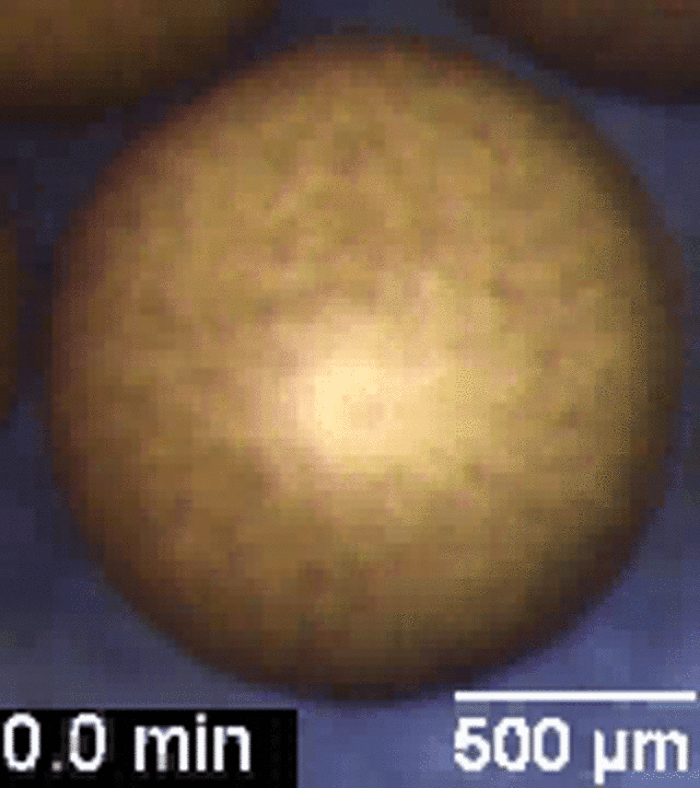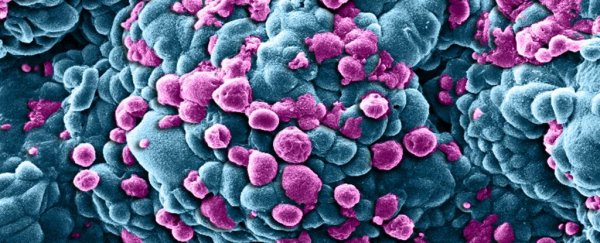For the first time, scientists have watched death moving through a cell, and measured the speed at which it travels.
The signals that trigger apoptosis - a type of cell suicide, also known as programmed cell death (PCD) - cascade through the cell in a wave, at a rate of three micrometres (0.003 millimetres) per minute.
The wave signalling process is called a trigger wave. If you think of a forest fire spreading from a single point, or a circle of dominoes falling inwards, you have a good understanding of how a trigger wave works.
But they're an important biological process in the everyday life of a cell, used for transmitting information quickly and reliably over long distances.
In multicellular animals, they're involved in the cell cycle, where cells divide to create new cells - this process is turned on throughout the cell using trigger waves.
They're also found in the brain as neuron action potentials - the propagation of electrical signals along the axon, are also trigger waves.
But this is the first time they've been implicated in cell death.
"This work is another example of how nature makes use of these trigger waves - things that most biologists have never heard of - over and over again," said biochemist James Ferrell of Stanford University.
"It is a recurring theme in cell regulation. I bet we'll start to see it in textbooks soon."
Apoptosis is one of the most understood form of cell death. It's the process whereby the body rids itself of old, unnecessary or unhealthy cells (such as those with mutations that could turn into cancer or those with an infection), without harming the surrounding tissue.
But even so, it's still something of a mystery. For instance, it doesn't always stop those mutated cells from becoming cancerous, or it overworks to devastating effect, knocking out healthy cells in the case of neurodegenerative diseases such as Parkinson's and Alzheimer's.
If we want to figure out how this happens - and, depending on the situation, either aid the process or slow it down - we need to know how apoptosis is regulated, the researchers said.
To see apoptosis in a cell, the researchers used the egg of an African clawed frog. They removed the cytoplasm from the egg - all the material except the nucleus - and placed it in a tube. Then they initiated apoptosis, using a green fluorescent protein that glows when apoptosis occurs.
This green glow moved down the tube at a constant speed, indicating that apoptosis was spreading via trigger waves, as opposed to chemical diffusion, the much slower method of communicating.
The next step was to see if this process also occurred in the cell in its natural state, but because frogs' eggs are quite opaque, using fluorescence microscopy would not be as helpful.
But when they induced apoptosis in an intact egg, they noticed that its colour changed, darkening as the cell died. This change occurred in a curved wave across its surface at a constant speed, indicating a trigger wave.
 (Cheng & Ferrell/Science)
(Cheng & Ferrell/Science)
When they analysed the eggs, they found activated caspases - types of enzymes that play a critical role in programmed cell death - in the eggs that had undergone this colour change. The living eggs, on the other hand, did not have these activated caspases.
They determined that, once cell death is initiated, these caspases activate. These then spread to other nearby caspases, and so on and so forth, like those dominoes falling, until the whole cell has carked it.
The next place the team wants to look for trigger waves is the body's immune response, to determine if the mechanism plays a role in how it spreads throughout the body.
"We have all this information on proteins and genes in all sorts of organisms, and we're trying to understand what the recurring themes are," Ferrell said.
"We show that long-range communication can be accomplished by trigger waves, which depend on things like positive feedback loops, thresholds and spatial coupling mechanisms. These ingredients are present all over the place in biological regulation. Now we want to know where else trigger waves are found."
The team's research has been published in the journal Science.
